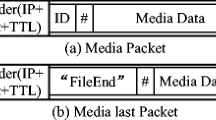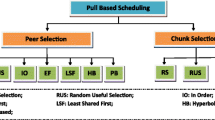Abstract
In recent years, the computing paradigm changes dramatically because a wide range of computing devices are deployed rapidly. These changes of computing environment mean that the computing paradigm has been moved to the computing paradigm based on cloud & grid computing from PC oriented client/server computing paradigm. It also means that hybrid peer-to-peer network technologies have very important roles in this paradigm shift. But so far, these changing of the computing circumstances can not be provided a satisfaction in terms of quality of service, and it is also the same in the hybrid peer-to-peer networks. In particular, although the quality of service mechanism which reflects the changing of these paradigm has to be introduced to the networks, a study of QoS provisioning mechanism is yet, insufficient. In this paper, Qos-Aware Data Forwarding Architecture (QDFA) is proposed to guarantee QoS of multimedia streaming services in hybrid peer-to-peer networks. The proposed QDFA performs end-to-end synchronization processes to provide QoS of multimedia streaming services. In the synchronization processes, QDFA measures accurate time based on IEEE 1588, and sets the synchronized paths. when transmits the packet to the synchronized paths, the proposed QDFA based on the synchronized time bypasses the packet to the next hop without processing delay. The proposed QDFA guarantees multimedia streaming service quality in hybrid peer-to-peer networks through these mechanisms. To prove the excellence of the proposed QDFA, it is compared with other packet forwarding scheme through OPNET.













Similar content being viewed by others
References
di Costanzo A, de Assuncao MD, Buyya R (2009) Harnessing cloud technologies for virtualized distributed computing infrastructure. IEEE Internet Comput 13(5):24–33
Keahey K, Tsugawa M, Matsunaga A, Fortes JAB (2009) Sky computing. IEEE Internet Comput 13(5):43–51
Pallis G (2010) Cloud computing—the new frontier of internet computing. IEEE Internet Comput 13(5):70–73
Hwang K, Li D (2010) Trusted cloud computing with secure resource and data coloring. IEEE Internet Comput 13(5):14–22
Chang L, Pan J, Xing M (2013) Effective utilization of user resources in PA-VoD systems with channel heterogeneity. IEEE J Sel Areas Commun 31(9):227–236
Manish P, AbdelBaky M, Ivan R, Aditya D (2013) Cloud paradigms and practices for computational and data-enabled science and engineering. Comput Sci Eng 15(4):10–18
Yan Zhang X, Zhou YL, Wang B, Ci S (2013) A novel cooperative caching algorithm for massive P2P caches. Peer-to-Peer Netw Appl 6(4):425–433
Shen H, Li Z, Li J (2013) A DHT-aided chunk-driven overlay for scalable and efficient peer-to-peer live streaming. IEEE Trans Parallel Distrib Syst 24(11):2125–2137
Hwang I-S, Liem AT (2013) A hybrid scalable peer-to-peer ip-based multimedia services architecture in ethernet passive optical networks. J Lightwave Technol 31(2):213–222
Montazeri A, Akbari B, Ghanbari M (2012) An incentive scheduling mechanism for peer-to-peer video streaming. Peer-to-Peer Netw Appl 5(3):257–278
Ferrant J-L, Ruffini S (2011) Evolution of the standards for packet network synchronization. IEEE Commun Mag 49(2):132–138
Ouellette M, Ji K, Liu S, Li H (2011) Using IEEE 1588 and boundray clocks for clock synchronization in telecom networks. IEEE Commun Mag 49(2):164–171
IEEE, IEEE standard profile for use of IEEE 1588 precision time protocol in power system applications, IEEE Standard C37.238, pp. 1–66, 2011
Chao H, Chen M, Xing C, Bo X (2012) EUE principle of resource scheduling for live streaming systems underlying CDN-P2P hybrid architecture. Peer-to-Peer Netw Appl 5(4):312–322
Shakkottai S, Srikant R, Ying L (2011) The asymptotic behavior of minimum buffer size requirements in large p2p streaming networks. IEEE J Sel Areas Commun 29(5):928–937
Luan H, Kwong K-W, Hei X, Tsang DHK (2010) Adaptive topology formation for peer-to-peer video streaming. Peer-to-Peer Netw Appl 3(3):186–207
Kleis M, Radier B, Elmoumouhi S, Carle G, Salaün M (2010) A decentralised service composition approach for peer-to-peer video delivery. Peer-to-Peer Netw Appl 3(3):222–236
Papagianni C, Leivadeas A, Papavassiliou S, Maglaris V, Cervello-Pastor C, Monje A (2013) On the optimal allocation of virtual resources in cloud computing networks. IEEE Trans Comput 62(6):1060–1071
Chen W, Cao J, Wan Y (2013) QoS-aware virtual machine scheduling for video streaming services in multi-cloud. Tsinghua Sci Technol 18(3):308–317
Acknowledgements
This work was supported by the Gyeongsangnam, Changwon Science Research Park Project of the Grant of the Korean Ministry of Science, ICT and Future Planning. And, this research was supported by the MSIP (Ministry of Science, ICT & Future Planning), Korea, under the C-ITRC (Convergence Information Technology Research Center) support program (NIPA-2013-H0301-13-1006) supervised by the NIPA (National IT Industry Promotion Agency).
Author information
Authors and Affiliations
Corresponding author
Rights and permissions
About this article
Cite this article
Kim, S. QoS-aware data forwarding architecture for multimedia streaming services in hybrid peer-to-peer networks. Peer-to-Peer Netw. Appl. 8, 557–566 (2015). https://doi.org/10.1007/s12083-014-0256-4
Received:
Accepted:
Published:
Issue Date:
DOI: https://doi.org/10.1007/s12083-014-0256-4




